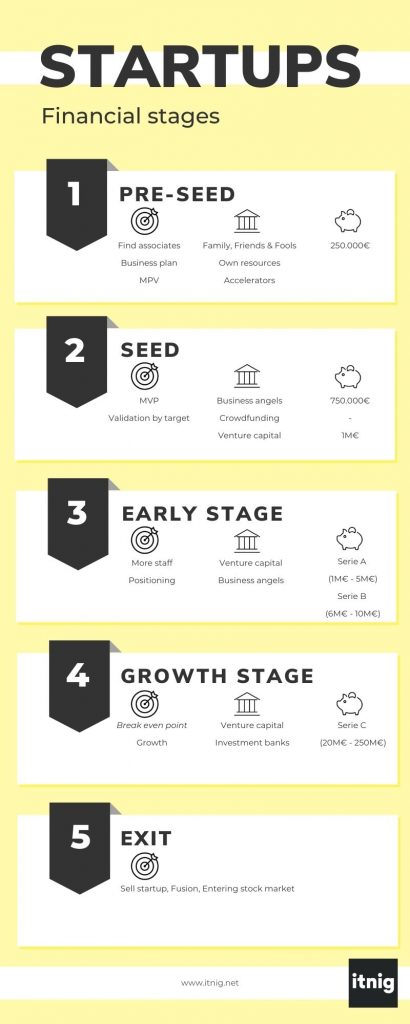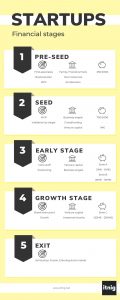In this guide, you will learn how to raise funding for startups depending on the stage where your business is.
Before turning an idea into a project, every entrepreneur has to study how to raise funding for startups. Funding is key for it to survive, and the founding team should be aware and have a clear idea of which are the different types of investment the company might need throughout the different stages of its life cycle.

What does ‘startup’ mean?
Defining the term startup is necessary before talking about how a startup gets funding. With this word we make reference to all the young companies that do not stick to the old-corporate game, which have a great growth potential given that they offer an innovative and technological solution to the market. Their purpose is completely focused on the client, and they usually have funding problems.
The business model they follow during their first years is based on the lean startup methodology. The main idea behind this method is that the startup should bring to the market a minimum viable product as fast as possible. By doing so, the first clients, also known as early adopters, will test the product and give feedback to the entrepreneur. These consumers are the first ones who try innovative solutions, so for them, effectiveness is more important than perfection. The team should keep this in mind when analyzing the metrics to develop the final product. In other words, the lean startup method means testing the project with potential clients as soon as possible in order to learn from the mistakes made during the process.
The startup environment becomes trickier when we come to analyze its life cycle, which is determined by different stages. Each phase has its objectives and needs, so it directly conditions the way the startup should raise funding, which is key for the development of the project. For that reason, we will explain how to raise funding for startups through the definition of each stage.
Funding for startups
Pre-seed startup funding
The pre-seed stage is the birth of the project. The entrepreneur has an idea which is drafted on a whiteboard to visualize the concept he has in his mind. It needs to be developed, but to do so, the entrepreneur should gather a team to help him validate the business model by creating the minimum viable product.
Since the idea is still intangible, there are no metrics to present to possible investors. The businessman/woman and its associate are the only people who really know about the potential of the project. In this case, the possibilities to raise funding for startups are:
- Own resources: If the entrepreneurs are the principal investors of the idea, they will be even more encouraged to commit to the company. Apart from being a logical first way of funding, it might be a good strategy to boost motivation among the team to make the idea a great and real project.
- Family, Friends, and Fools: Asking your family members, friends, and colleagues to raise money for the project is always a good option. These are people who are close to the entrepreneur, meaning that they trust and believe in him. Additionally, as in the fund describe before, since the money being used is from cared ones, the teammates will feel more encouraged to work hard on the project and commit to it.
- Accelerators: These are companies that can be defined as a micro startup-ecosystem. When turning to this type of investor, the entrepreneur will find, not only an economic fund but a consulting team. So, the advantage in this case is that the startup team will find financial and guidance aid.
The project is still not materialized, so it is risky and difficult to look for external funding. Financially speaking, it is the most difficult stage for the company, but if the entrepreneur and his team manage to demonstrate the project’s potential, their funding options will increase.
Stage: Pre-seed
Objective: Finding associates, develop business model and prototype
Funds: Own resources; Family, Friends and Fools; Accelerators
Volume: It depends on the project’s needs (<= 250.000€)
Seed startup funding
It is one of the most important phases within the startup life cycle. The idea has been developed, there is a tangible project since the prototype has been elaborated. The funding objective now is to raise money to frame the MPV so it can be brought to the market. From that moment on the early adopters will be able to test it and give feedback. The economic need is bigger now, so the project creators should look for external funding such as:
- Business angels: It is a private investor who, by itself or with other associates, invest in startups contributing to what is known as intelligent money. This means that the project will receive financial capital but also contacts, a coworking environment to work, and tacit knowledge. This type of startup funding is really common in countries such as the United States and Israel.
- Crowdfunding: It is a financial solution that is becoming more popular in the startup fund-raising sector. Entrepreneurs can present and promote their projects on crowdfunding websites to raise the needed fund within a period of 120 days. The contributions collected come from people who read about the project and are interested in the business model set out.
- Venture capital: These are private investment funds whose objectives are to invest in startups in order to obtain benefits in the short term. Taking this into account, the firms will consider the metrics and decide if the project has enough growth potential. The entrepreneur can apply to this type of funds through funding events known as pitch to investors, where the business model is promoted in front of the possible future group of people who will invest in the project.
This stage usually requires raising a fund of 750.000€ – 1M€.
Stage: Seed
Objective: Bringing MPV to the market and validation of the business model by the target
Funds: Business angels, Crowdfunding, Venture Capital
Volume: 750.000€ – 1M€
Early-stage startup funding
The MPV has been successfully tested by the early adopters. The startup has been able to collect feedback which will be used to elaborate on the final product. Now is the moment to raise funds to bring more staff to the team and potentiate the added value in order to differentiate the startup from its competence.
In this stage, the entrepreneur usually looks for raising fund rounds known as series A (between one and five million euros) and series B (between six and ten million euros). Since the idea is ow a business and the economic help needed is more important, it might be interesting to look for investors specialized in early-stage startup funding such as:
- Venture capital
- Business angels
Stage: Early stage
Objective: Look for more staff, positioning
Funds: Venture capital, Business angels
Volume: Series A (1M€ – 5M€) – Series B (6M€ – 10M€)
Growth stage startup funding
The startup has already taken its place on the market, it has its own recurrent paying clients and positive metrics. Considering that, growth strategies should start to be developed in order to reach a wider market and get to the breakeven point (the point where the startup starts having benefits).
Once the cash flow is positive, the entrepreneur and his team should reach to investors who can be able to raise series C funds (economic volume between 20M€ – 250M€).
- Venture capital
- Investment banks
Stage: Growth stage
Objective: Reach breakeven point, growth strategies
Funds: Venture capital, Investment banks
Volume: Series C (20M€ – 250€M)
Exit stage
If the project has reached this point, the idea that was drafted on a whiteboard has become a success. The founding team does not need to keep worrying about how to raise funds since it is the end of the startup life cycle. The conclusion can be shaped as a sale/fusion with other companies or entering the stock market.
This stage doesn’t mean that the founder should leave the project behind, the exit strategy will define how to conclude the startup phase of the company.
Stage: Exit
Objective: Sell startup, Fusion, Enter stock market
It is necessary to clarify that not all projects get to this final stage. Some fail during the process because of many different reasons, such as not knowing how to raise funds for startups. Making mistakes is an important part of the process since it helps to ensure a more successful future project.

Knowing what investors look for when they listen to entrepreneurs promoting their projects might be helpful to ameliorate the pitch and reach your goal: raising funds for the startup. If you want to learn about it, you can listen to the chapter of our podcast: Nauta Capital & Active Venture Partners on metrics, entrepreneur execution and the EU VC scene.

As a startup ecosystem, Itnig has an early-stage startup fund that is constantly looking for new interesting projects. Every Thursday at 7 PM we have our pitch to investors where you can present your business plan to our founders.
We encourage you to apply so we can learn about your idea!
I am looking preseed fund.